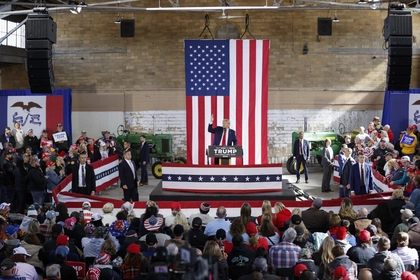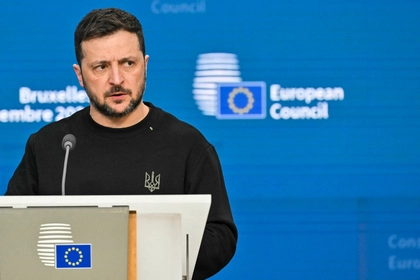I am old enough to clearly remember the Reagan administration in America during the 1980s. In fact, the first vote I was legally old enough to cast was for Ronald Reagan in 1980. At the time, I was a registered Republican serving on active duty in the US Army in Germany.
Reagan swept into office on Jan. 20, 1981 with the expectations of the American public running high. People were tired of almost non-stop bad news and looking forward to a drastic change in the direction of the country. We had just experienced a very difficult decade in the 1970s: long gas lines, the Iran hostage crisis and subsequent bungled rescue attempt in the Iranian desert, the near bankruptcy of New York City, Watergate and double-digit inflation.
JOIN US ON TELEGRAM
Follow our coverage of the war on the @Kyivpost_official.
In 1979 President Jimmy Carter summed up the frustration of the American people in a speech that came to be called the “great malaise” speech. All in all, it was the perfect time for a new kind of leader to appear on the American political scene, one that could energize the falling spirits of Americans and turn the country’s fortunes around. Ronald Wilson Reagan, the former California Governor and movie actor seemed to be made in Hollywood just to fill that role.
When Reagan was inaugurated as the 40th president of the United States on Jan. 20, 1981, expectations for him and America running high. Starting on day one, he did not disappoint. Within only minutes of his inauguration the last of the 52 American hostages were released from Iranian custody after being held hostage in the American Embassy in Tehran for 444 days.

North Korea Slams US Criticism Over Troops in Ukraine, Calls It ‘Reckless Provocation’
It was quite an auspicious start to his presidency and American spirits, including mine, soared. After that it was easy to feel that a new era had begun in America, an era of renewal.
Unlike today, during the 1980s there was never any doubt about who the real danger was to the United States and Europe. That part was played expertly by the Soviet Union, a decades long adversary of the West, referred to as the “evil empire”, by President Reagan.
Reagan was very clear that he had no love for the Soviet Union or any of their leaders. Communism and capitalism were not ideological brothers to him, and authoritarianism and democracy didn’t mix. Although he had several photo ops with Soviet leaders, most notably with Mikhail Gorbachev, there was never any doubt of the utter distain Reagan felt towards the Kremlin. His love of freedom came through in a line from his memorable speech: “Mr. Gorbachev, tear down this wall!”
To many analysts, me among them, the union busting action involving the federal air traffic controllers strike by Reagan in 1981 was the accelerant that jump started what eventually became the MAGA (Make America Great Again) movement – the angry, often violent, and allegedly disenfranchised American middle class loyal only to Donald Trump and hating anything remotely considered to be liberal or Democrat. Many considered that action by Reagan to be the beginning of the end for the American middle class. Ironically, they do not seem to realize that their anger should probably be focused not on the liberal Democrats, but on the party of Trump.
Reagan Republicans vs MAGA Republicans
One of the key points that many make when comparing the Reagan Republicans to the MAGA Republicans is the amount of cooperation, compromise and civility that was possible between parties in the 1980s. There were certainly many ideological differences between Democrats and Republicans during those years, even eight brief government shutdowns, but for the most part they found a way to work together to successfully get important legislation passed.
In my opinion there were two primary reasons for that success. The first was that both parties shared the same set of moral values and national goals. With rare exceptions, elected officials of both parties took their oath of office to protect and defend the Constitution of the United States very seriously.
There have always been grifters and opportunists among elected officials in America, but we have never seen so many blatantly disregard their oaths of office so quickly, all in service to one man.
No Reagan Republican would ever even hint at being a friend of a Soviet leader, or place Soviet intelligence services above American intelligence services, or speak proffer “whataboutism” comparing Soviet KGB assassinations to American covert operations. No Reagan Republican would ever publicly disparage NATO, hint at not honoring Article 5 of the NATO charter in case of a Soviet invasion, or talk about the US leaving that organization.
However, we no longer have a Reagan Republican in the White House and haven’t since at least since George W. Bush in 2008. We also no longer have a Republican Party willing to compromise in order to pass legislation with Democrats.
What we do have, unfortunately, is a Republican Party that have been taken over by Donald Trump and his MAGA supporters. Although true MAGA believers make up less than a majority in the Congress, they hold an oversized control of the Congressional Republicans because of the strength of the MAGA electorate. These extremely enthusiastic Trump supporters object to Republican officials making any sort of compromise with Democrats, and will actually oppose any actions taken by Democrats just to sabotage the Democrat’s agenda. There is a saying in American politics: “If you’re for it, then I’m against it!” Those words were never more evident than in today’s polarized American political scene.
The current members of the Republican Party seem to have sold their souls to Trump and MAGA in exchange for raw power, and for the adulation they can receive from MAGA viewers on Fox News, or talk radio, or on social media. There have always been grifters and opportunists among elected officials in America, but we have never seen so many blatantly disregard their oaths of office so quickly, all in service to one man. The fact they are selling out American national security interests is of no concern to them apparently.
In addition, because Donald Trump feels a perverse kinship to Vladimir Putin, he opposes any more American aid to Ukraine. That fact is more than enough reason for MAGA to adopt their leader’s position on Ukraine and Russia, including Putin. If Trump likes him, so do they. As many have said, Ronald Reagan must be spinning in his grave at the treasonous behavior being displayed by so many of his fellow Republicans. I cannot but agree.
Trump as linchpin against Ukraine
But where does all of the almost visceral MAGA opposition to Ukraine come from? I would argue there are two primary reasons.
First, the success of the Russian disinformation campaign that helped Trump, starting with the run up to the 2016 election, is a major factor. Even today, most Trump supporters have no idea that many of the “fellow Republicans” with whom they chatted on social media in 2015-2016 were in realty GRU cyber operatives located in St. Petersburg, Russia, feeding them Kremlin lies and propaganda. When confronted with this fact afterwards, many Trump voters refused to believe the truth and called it “fake news” made up by Democrats and CNN. This unrelenting cyber-assault by Russian operatives and bots on Trump supporters has only increased since then, and it paints a totally alternate reality of Russia, Putin, Zelensky, Biden and the war in Ukraine for gullible Trumpists.
The other primary reason for the growing lack of support for Ukraine is quite simply, Donald Trump. I already mentioned his attraction to Putin and vocal opposition to supporting Ukraine. Donald Trump has such a grip on the Republican Party that his opinion immediately becomes party doctrine. He admires Putin and dislikes Zelensky, therefore he seeks praise from Putin and will not agree to any further support for Ukraine. What Trump wants, his MAGA supporters want, and MAGA strongly influences (often verbally threatens) their elected Republican representatives to go along with Trump’s policy on Ukraine and Russia or they will vote them out of office, or worse.
Republican politicians very clearly see the power of Trump over MAGA voters and know it is political suicide to oppose him (or them). They are also rightfully frightened of the threats, both physical and political, made to them by MAGA. Therefore, they try to outdo each other in opposing aid for Ukraine. In fact, publicly opposing further aid to Ukraine for Republican politicians has become a kind of litmus test for retaining support from within the Republican party and MAGA voters.
Most recently, this loyalty test this has resulted in all aid for Ukraine being stripped from the temporary federal budget passed by the US Congress on Sept. 30. Depending on who becomes the next Speaker of the House of Representatives, that aid may never make it back into another federal budget. If it does, it might possibly be included in a much-reduced amount within a supplemental budget submitted by Democrats – but with major political concessions to the MAGA Republicans.
The linchpin in all of this is Donald Trump. On Trump rides the future of any further American assistance for Ukraine, US membership in NATO, and possibly the very future of democracy in America itself.
The views expressed in this opinion article are the author’s and not necessarily those of Kyiv Post.
You can also highlight the text and press Ctrl + Enter






